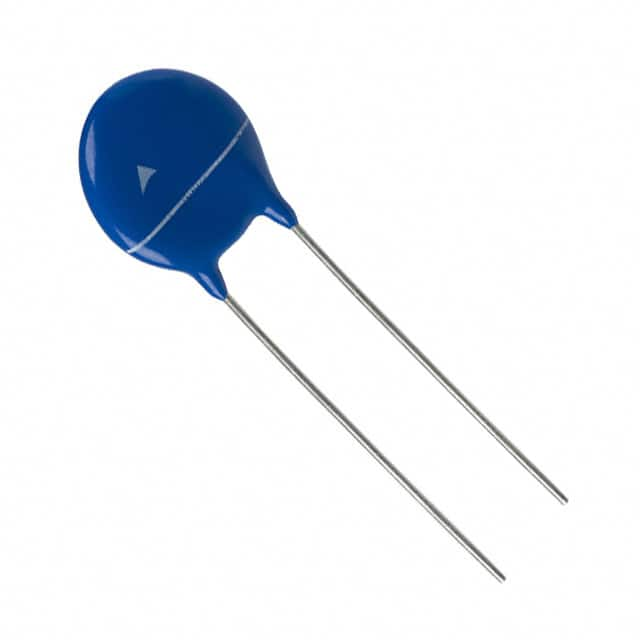B72214S0171K101
Product Overview
Category
The B72214S0171K101 belongs to the category of varistors, which are electronic components used for voltage regulation and surge protection.
Use
This varistor is commonly used in electronic circuits to protect sensitive components from voltage spikes and transient overvoltage conditions.
Characteristics
- High energy absorption capability
- Fast response time
- Wide operating temperature range
- Low leakage current
Package
The B72214S0171K101 varistor is typically available in a disc-shaped package with lead wires for easy integration into circuit designs.
Essence
The essence of this varistor lies in its ability to rapidly absorb and dissipate excess electrical energy, thereby safeguarding connected devices and components.
Packaging/Quantity
These varistors are usually packaged in reels or trays, with quantities varying based on customer requirements.
Specifications
- Voltage Rating: 175V
- Maximum Allowable Voltage: 340V
- Peak Current (8/20µs): 4500A
- Energy (10/1000µs): 2.5J
- Operating Temperature Range: -40°C to +85°C
Detailed Pin Configuration
The B72214S0171K101 varistor typically has two lead wires for connection to the circuit. The pin configuration may vary based on the manufacturer's specifications.
Functional Features
- Non-linear voltage-current characteristics
- Rapid response to overvoltage conditions
- High energy absorption capacity
- Stable performance over a wide temperature range
Advantages and Disadvantages
Advantages
- Effective protection against voltage surges
- Fast response time
- Wide operating temperature range
- Reliable performance in demanding environments
Disadvantages
- Limited lifespan under continuous high-stress conditions
- Sensitivity to extreme voltage fluctuations
Working Principles
When an overvoltage condition occurs, the varistor conducts current, diverting the excess energy away from the protected circuit. This rapid response helps prevent damage to sensitive components.
Detailed Application Field Plans
The B72214S0171K101 varistor finds applications in various fields, including: - Power supply units - Industrial equipment - Telecommunications systems - Automotive electronics - Consumer electronics
Detailed and Complete Alternative Models
- B72214S0271K101
- B72214S0371K101
- B72214S0471K101
- B72214S0571K101
In conclusion, the B72214S0171K101 varistor offers reliable surge protection and voltage regulation capabilities, making it a crucial component in diverse electronic applications.
Word Count: 398
Lista 10 Vanliga frågor och svar relaterade till tillämpningen av B72214S0171K101 i tekniska lösningar
What is the B72214S0171K101 component used for in technical solutions?
- The B72214S0171K101 is a metal oxide varistor (MOV) that is commonly used for overvoltage protection in various electronic and electrical systems.
What are the key specifications of the B72214S0171K101?
- The B72214S0171K101 has a voltage rating of 175V, a maximum surge current of 2500A, and a capacitance of 1000pF.
How does the B72214S0171K101 provide overvoltage protection?
- When an overvoltage condition occurs, the B72214S0171K101 conducts current to divert the excess energy away from sensitive components, thereby protecting them from damage.
In what types of applications is the B72214S0171K101 commonly used?
- The B72214S0171K101 is often used in power supplies, industrial equipment, telecommunications devices, and automotive electronics to safeguard against transient voltage spikes.
What are the typical failure modes of the B72214S0171K101?
- The B72214S0171K101 can fail due to prolonged exposure to overvoltage conditions, excessive current surges, or aging, which may lead to decreased protection capability.
Are there any specific mounting or handling considerations for the B72214S0171K101?
- It is important to follow the manufacturer's guidelines for proper mounting and handling to ensure the reliability and effectiveness of the B72214S0171K101 in providing overvoltage protection.
Can the B72214S0171K101 be used in outdoor or harsh environments?
- Yes, the B72214S0171K101 is designed to withstand a wide range of environmental conditions, making it suitable for outdoor and industrial applications.
What are the alternatives to the B72214S0171K101 for overvoltage protection?
- Other alternatives for overvoltage protection include gas discharge tubes (GDTs), transient voltage suppressors (TVS diodes), and silicon avalanche diodes (SADs).
How can the performance of the B72214S0171K101 be tested in a circuit?
- The B72214S0171K101's performance can be evaluated using surge tests, impulse tests, and voltage clamping measurements to ensure its effectiveness in protecting the circuit.
What are the potential safety considerations when using the B72214S0171K101 in technical solutions?
- Users should be aware of potential hazards associated with overvoltage events and ensure that proper safety measures are in place to protect personnel and equipment.


